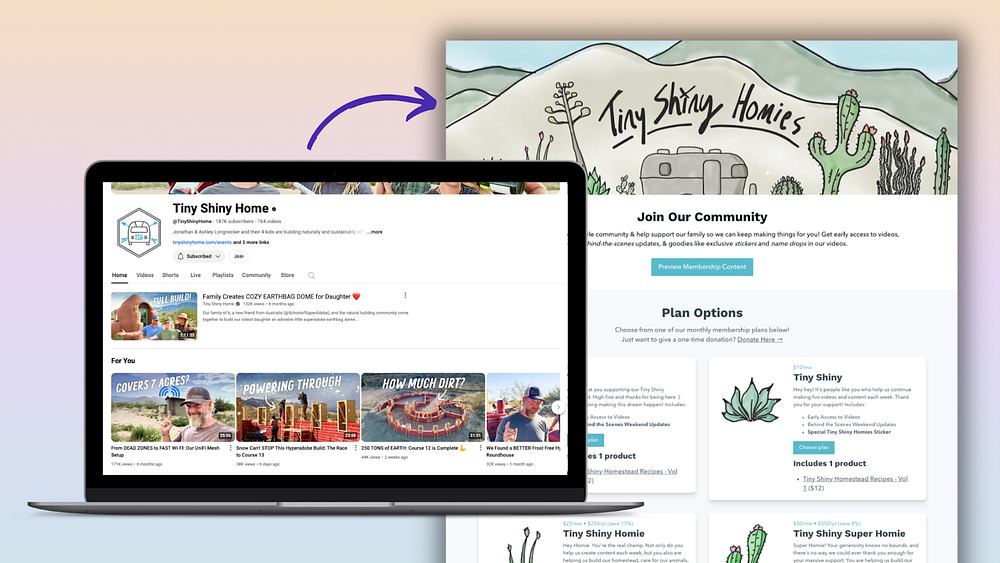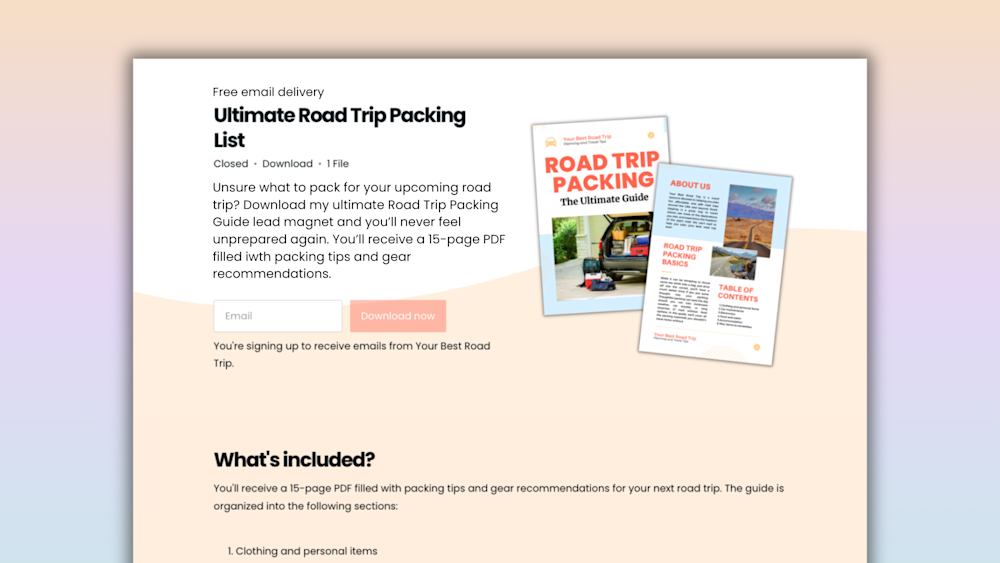Building a blog is like learning to ride a bike. It takes practice, and you’ll fall down often, but when everything clicks, it feels euphoric.
Like riding a bike, the best way to become a blogger is to grab hold of the handlebars and put your feet on the pedals. You can’t become an expert by reading or watching tutorials; you’ve just got to do it, scrapes and all.
But you don’t have to do it alone.
Whether you’re a total newbie or you’ve been around the block a time or three, making mistakes is part of being a blogger. Today, I’m pulling back the curtain to reveal 15 common blogging mistakes people make and what to do instead.
With five years and three blogs under my belt, I’ve smashed my bike tires into nearly every curb in the neighborhood. There’s no reason you should too.
Use this guide as a set of training wheels to kick off your successful blogging career. I can’t wait to see how far you ride.
Mistake #1: Not having a clear purpose for your blog
One of the biggest mistakes new bloggers make is starting without a clear goal.
You don’t need to have everything figured out from day one (no one does), but having a general direction allows you to be more intentional with your time and creative energy.
No sense building a luxury skyscraper when you really want a cottage by the lake, right?
The blog you make will look very different depending on your desired outcomes.
Some people start a blog to promote an existing small business or product. Considering that companies that blog get 55% more website visits, blogging can be a great complement to your other marketing efforts.

Others get into blogging to become their own boss and make money online. A 2020 study of over 1000 bloggers found that about 16% started blogging to become self-employed, and 12% did it to earn more money.
But the most common reason people get into blogging? It’s fun! That same study found that just over 24% of bloggers started a blog as an outlet for creative expression.
All of these are valid reasons to start a blog, but your priorities will differ if you’re blogging as a hobby, marketing strategy, or income opportunity.
For example, a creator who wants to earn money blogging might prioritize affiliate content. On the other hand, a creator looking for a cozy place to flex their writing chops won’t need to think of monetization at all.
Before you commit, think about what you want to get out of blogging. What does success look like for you? Having a goal will prevent you from getting lost in the weeds down the line.
Mistake #2: Blogging without a niche
Let’s pretend you’re starting a vegetable garden. You need some advice, so you head to the internet. Which website appeals to you more: a general blog about growing dozens of plant species or a blog specifically about growing a garden full of veggies?
Chances are, you’ll go with the second blog since it’s more aligned with your interests. Plus, you can assume that the author is an expert in vegetable gardens since that niche is the sole focus of their website.
A niche is a single topic at the center of your creative work. Of bloggers who earn over $50,000 per year from their sites, 73% focus on serving a particular niche audience.

Having a niche gives you a few advantages:
Thoroughness: When you stick to a specific concept, you can cover it in more detail than if you were writing about several different interests.
Expert status: You want to be known as “that veggie garden guru” in the minds of your readers, but that probably won’t happen if your blog also covers beauty products, vacation destinations, and interior design.
Search engine advantages: At a basic level, when someone types a question into a search engine, the algorithm must pick the best websites to display in the results.
If your site extensively covers a single topic, search engines could see it as more authoritative and comprehensive than competitors. The result? Greater visibility, higher rankings, and more traffic.
Simply put, having a niche can keep your content cohesive, establish your expertise, and give you a leg up in the search results.
But picking a niche can be tricky. You probably have several interests you want to share with the world. How are you supposed to choose just one?
Try using the Passion/Profit matrix.
Think of topics that you love to write about — no sense blogging if you’re not interested in your subject matter — and topics that are profitable.
To determine if a topic is profitable, ask yourself these questions:
-
Do people already spend money to address this problem?
-
Do people already spend time researching this problem?
Next, plot your ideas based on enjoyment level and earning potential. Your ideal niche is in the “high passion” and “high profit potential” quadrant.

There’s one big caveat to this, though. If you’re blogging as a creative outlet, don’t get too hung up on having a niche. Go forth, blog freely, and have a blast.
If you’re trying to make money and grow quickly, on the other hand, a niche will likely get you there faster.
Mistake #3: Focusing on your own interests instead of your audience
I know it sounds counterintuitive, but the blogger in charge isn’t the most important person when planning posts. It’s all about the audience.
Instead of thinking about the articles you want to write, focus on creating content your target audience wants to read.
How do you figure out what your audience wants to read?
Start your market research by checking forums on Reddit and Facebook to see what questions people ask in your niche.
You can also type keywords in the search bar on YouTube, Google, and Pinterest to see what suggested queries come up. These are popular phrases that real people search for, and you can use these as blog post topics.

If you already have an audience, periodically send out surveys to learn about their interests and pain points.
Last year, I sent out a survey to see what my followers wanted to read about in the upcoming months. The results were enlightening and gave me tons of ideas for my content calendar.
Of course, there’s nothing wrong with occasionally sharing life updates and quirky interest posts, but the bulk of your content should help, inspire, inform, and entertain your audience.
Mistake #4: Skipping steps when setting up your blog
It’s tempting to rush through the blog setup process, but it’s best to take your time and sort out all the technical stuff from day one.
Podia has a free blogging feature that includes hosting, storage, and unlimited blog posts, and you can connect a custom domain on Podia's plans (which starts at $33 per month). Podia blogging is an easy, straightforward option for new bloggers, and there's a blog post importer if you already have blog posts on another platform.
If you'd like to use a different platform for blogging, two popular options are WordPress and Squarespace.
Next, you’ll need to buy a domain name. Podia blogs come with a free Podia subdomain, but if you want a custom one, basic plans with popular providers like Bluehost and SiteGround start at less than $10 per month.

If you go with WordPress, you'll also need to sign up for website hosting. Website hosting is like renting space for your website online.
Finally, dedicate a weekend to watching tutorials, learning about plugins, and reading up on website configurations for your platform of choice.
About two years into my first blog, I spent an entire month updating articles and rebuilding my website structure after learning that my site was not optimized correctly. Looking back, I should have done more research in the earlier stages to avoid the mess later on.
For more information on blog platforms, web hosting, and the technical side of blogging, check out this guide on how to start a blog.
Mistake #5: Ignoring SEO and keyword research
Many bloggers learn about search engine optimization (SEO) and keyword research later in their journey. You can set yourself apart by studying these valuable skills from day one.
SEO is a system for creating content that ranks well in search engines, namely Google. The higher your posts rank, the more website views you’ll likely receive. 71% of bloggers say SEO is an important source of the traffic to their blog.
Keywords are the phrases and questions that people type into the search bar. Ideally, when people search for topics related to your niche, your content should appear.
Keyword research can:
-
Show you how many people search for each phrase
-
Reveal the exact language your audience uses to look for information
-
Give you ideas for helpful blog posts
With this knowledge, you’ll be able to create content that’s better aligned with your audiences’ needs. The numbers don’t lie: high-earning bloggers are 4.3x more likely to do keyword research compared to bloggers who earn less.

To conduct keyword research, I like using an affordable tool called Keysearch. The program generates a list of keywords for your niche topic and shows you the monthly search volume for each phrase.
If you have the budget for it, you can also check out premium research tools like SEMRush and Ahrefs, but plenty of inexpensive SEO tools get the job done.

Learning a few basic SEO tips early on will help you understand how search engines work and interact with your website.
For a deeper dive into all things SEO, check out our guide to SEO for creators and our list of free SEO tools.
Mistake #6: Writing blog posts without proper formatting
Blogging is much more than typing your thoughts into a webpage, but you already knew that. Here are some strategies to make your content perform well and look great.
Write about one topic per post: Each blog post should cover one specific topic. Ideally, the main idea should be a keyword that you found using the tools listed in the previous section.
It’s important to provide the most thorough content possible without unrelated digressions.
For example, if you’re writing about how to bake a cake from scratch, create the most detailed article you can about making cakes, but only cakes. Don’t add a section about pies and tarts. Stick to only one topic per post.
Format posts for easy reading: When formatting your post, use headings and subheadings so readers can skim easily. Break up paragraphs so they’re only a few lines long, and include eye-catching media like images, infographics, and videos.
Always proofread your posts: Before posting, remember to edit and revise your posts. Consider running your articles through a proofreader and grammar checker like Grammarly. This tool can also check for plagiarism on the pro plan.
That said, proofreading tools can’t replace human editing. It’s always best to give your post a readthrough with your red pen or have someone else take a look at it before publishing.

Include external and internal links: If you’re citing data or statistics, remember to add external links to the source.
Also, if you’ve written several posts around one blog topic, include links to related articles within each piece of content. This practice, called internal linking, can show search engines that your website is more comprehensive than competitors.
After all, who seems more trustworthy, a blog with one post about making a cake or a blog with heaps of quality content about cakes, icing, and decorating?
If you’re still unsure about writing and formatting content, check out our 4-step guide to writing a blog post.
Mistake #7: Skipping social media promotion
Publishing a good blog post can be exhausting, but your work isn’t done yet. You also need to promote your content.
Truthfully, this is an area that I still struggle with sometimes. After finishing a blog post, I’m ready to take a nap. The last thing I want to do is come up with a catchy social media post to match.
But 70% of high-earning bloggers actively promote their new blog posts, and admittedly, I do notice increased traffic when I consistently share articles on the right social media platforms.
For me, Pinterest marketing has been the most successful platform for blog promotion since Pinterest is a visual search engine, but this can vary depending on your niche and audience.

When asked where they prefer to share their work, 42.91% of bloggers said Facebook, and 21.07% said Instagram. Networks like LinkedIn, Twitter, Reddit, or TikTok are also popular places to promote your posts.
You don’t need to be active on every social media platform, but it’s a good idea to pick one or two that appeal to you and work on building an audience. You can always branch out in the future.
Mistake #8: Only writing content for your own blog without guest posting
A common blogging mistake people make is not guest posting on other sites. Guest posting is where you write an article for another blog in your industry. They publish the piece and include a link back to your blog in the credits or author bio.
Guest posting is a winning move for two reasons.
First, you gain valuable links back to your blog.
Backlinks tell search engines that your content is more authoritative. 94% of blog posts have no external links, so if you have some and your competitors don’t, you could get a huge advantage in the ratings.
Second, you can get more exposure within your niche.
When you write a post for a blog with a large viewership, you’re getting access to people who could become loyal readers and fans.

If you’re not sure where to find guest blogging opportunities, try reaching out to creators you admire in your niche.
73.3% of bloggers allow guest posts on their site, so why not send a thoughtful pitch to someone who inspires you?
Mistake #9: Not growing your email list
An email list is a significant asset for successful bloggers. Creators earning over $50,000 per year from their blogs are twice as likely to prioritize their email list than lower-income bloggers.
On a fundamental level, your email list is a direct way to communicate with your audience without having to worry about funky social media algorithms or platforms disappearing overnight. (Anyone else remember Vine?)
On an advanced level, you can use email to send customized messages, build community, and promote new projects. If you ever decide to sell your own products, email marketing is a highly effective way to let your followers know.
Wondering how to grow your email list? Free stuff!
53% of high-earning bloggers offer free content in exchange for email signups. These freebies, also called lead magnets, can be ebooks, printables, videos, templates, mini-courses, or anything else that provides value to your audience.
For example, Podia creator Natalie Sisson built her email list by giving away a free ebook about monetizing your knowledge and skills. Since her brand is all about helping others form profitable online businesses, this product is the perfect fit for her audience.

By offering an amazing free product, you show followers that you can provide value.
Many bloggers say that one of their biggest blogging mistakes was not growing an email list sooner. Get ahead of the curve by building yours from the start.
Learn more in this guide to email marketing for bloggers.
For email list inspiration, join ours below.
Mistake #10: Not updating old content for relevancy
Updating old content is just as important as writing new content. 38% of bloggers update their old content, and one case study even found that refreshing past posts resulted in 106% more traffic to those articles.

Since it’s usually faster to spruce up an existing post than write a new one, this is a great opportunity to get more visitors with less effort.
When creating your editorial calendar, aim to include posts that are evergreen. Evergreen posts stay relevant long into the future as long as they’re updated occasionally.
A post like “50 best journal prompts” never expires, whereas a post with information about an upcoming event in your town has a much shorter lifespan.
When you write high-quality, evergreen content that can be updated year after year, you’re saving yourself time and energy in the future.
Mistake #11: Not using Google Analytics and Google Search Console to your advantage
Google Analytics and Google Search Console are essential ingredients in your blogging recipe book. These free tools tell you what keywords your content ranks for and what posts receive the most traffic.

Before I started using these tools, I had no idea what content resonated with my readers. I was operating on assumptions.
When I started using these services, I quickly learned that one topic on my blog was driving the majority of my Google traffic. With that knowledge, I created more content around that subject to better serve my audience.
Both Google Analytics and Search Console are free to use, and there are plenty of online tutorials that show you how to set them up. Once you do, you’ll have access to a goldmine of information.
Mistake #12: Blogging alone and reinventing the wheel
Bloggers often face unfamiliar challenges. Courses and communities can help.
If you’re a beginner, a general “how to start a blog” course could save you hours of YouTubing scavenging the web.
Early on, I took one of these courses and learned tactics that almost immediately took my monthly page views from dozens to thousands.
If you’re further along in your blogging journey, consider taking advanced courses in areas like SEO, email list building, and affiliate marketing to deepen your knowledge.
It’s also important to find your blogging community. Figuring everything out alone is tough, and trust me, you’ll need to have blogging friends who get it on the days when you accidentally break your website or send a half-finished email to your entire list.

I’ve met some of my best blogger friends through in-person events like conferences and conventions. I’ve also connected with people in online communities and blogging Facebook groups.
Having a community can keep you on track, help you get answers to your questions, and make the process more fun.
Mistake #13: Only trying one monetization method
Nearly 60% of bloggers make money from their blogs, but everyone’s monetization journey is different. There are many blog monetization strategies, so it’s best to try a few to see what’s the most lucrative for you. Here are some ideas:
Advertisements: Brands place ads on your site, and you get paid per view. Any website can start with Google AdSense, but I recommend holding off until you meet the traffic threshold for a premium ad network like Ezoic, Mediavine, or AdThrive.

Affiliate marketing: You promote a product to your audience using a special referral link. If someone makes a purchase, you earn a commission. Affiliate marketing is one of my favorite ways to monetize since you don’t need ultra-high traffic, just the right audience.
Sponsorships: Brands pay you to promote a product or service to your audience. Unlike affiliate marketing, you receive a flat fee rather than a commission.
Selling digital products: You create digital downloads, ebooks, or online courses and sell them on your site. 45% of high-earning bloggers sell their own products or services.

Once you start seeing consistent traffic, tinker with these different methods to determine what compliments your goals and audience.
Speaking of selling digital products, let’s explore more ways to earn money while establishing your blog.
Mistake #14: Not having another stream of income while building your blog
Perhaps my biggest blogging tip is to maintain a day job or side hustle while building your online empire.
Getting your blog to the point where it consistently pays the bills takes a long time. And the truth is, 49.51% of bloggers make less than $1000 per month from their blog.
Being fully financially dependent on your blog, especially as a new blogger, can make things incredibly stressful. It can lead to burnout, and it might encourage you to take short-term wins, like working with an unideal sponsor, at the expense of long-term success.
To ensure you’re building a blog with longevity, give yourself some financial padding.
Many bloggers, myself included, earn money from freelance writing at some point in their careers. Others find flexible online jobs, virtual assistant positions, or other freelancing roles.
You can even create and sell digital products to complement your blossoming blog income. An all-in-one platform like Podia makes it easy to manage the logistics so you can let your creativity shine. Give Podia a try today with a free 30-day trial.

Blogging is meant to be enjoyed, so give yourself financial breathing room when you’re getting started.
Mistake #15: Forgetting that blogging is a long-haul game
The final mistake bloggers make is forgetting that blogging takes time. On average, it takes full-time content creators at least three years to start earning a significant income from their work.
You’ll see a lot of posts out there about people who made buckets of money in a matter of days, but don’t get discouraged if this isn’t your journey. It certainly wasn’t mine, and it’s okay for things to take time and grow.
Commit to the long-term experience of blogging, and enjoy the process. You’ll learn so much and open yourself up to a world of opportunities–financially, creatively, and professionally.
Simply put, it’s 100% possible to make a living blogging about a topic you’re passionate about. It takes strategy, work, time, and a healthy tolerance for mishaps, but you can do it.
So take a breath, fasten your helmet, and start pedaling. As you fly down the road with the wind in your hair, I hope you hear me cheering in the distance. You’re not alone, and you’ve got this.



